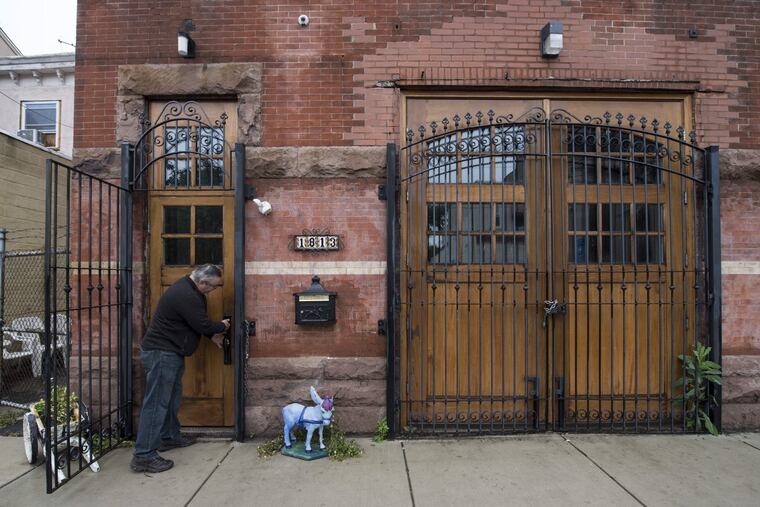Carving out an artists' haven in Camden: free studios, residences
Waterfront South is home to a growing number of arts and culture organizations.

Wanted: Artists looking for a place to live, a studio in which to labor, and a gallery for showing work to a fledgling community of other creative types.
There's no rent, there are no fees, and for a savvy young (or youthful) urbanite, there should be no problem in the fact that the community, the gallery, the studio, and the residence are in Camden.
"We're only asking each artist to do eight hours of work a week on art projects in the community," says Jack O'Byrne, executive director of the Camden Shipyard & Maritime Museum. "They'll help beautify Camden and build their [professional] track record."
Similar to an internship, each Waterfront South Artist Residency will last 10 weeks; applications are being accepted online for the first cohort of four artists, who will begin their residencies Oct. 1.
"They could have a major impact," says O'Byrne, who also is executive director of the Camden County Historical Society. He came up with the residency program as a way to bring fresh talent into the neighborhood, and to the charming work-in-progress that is the Shipyard & Maritime Museum.
Featuring interactive exhibits, maritime memorabilia, and a boat-building shop, the museum opened last year in a former Episcopal church. It sits diagonally across Broadway from the Camden FireWorks, where galleries, studios, and educational programs debuted last year in a handsomely restored Victorian-era firehouse.
FireWorks will offer free studio and gallery space to the resident artists, who will live in the century-old former rectory adjacent to the museum. About $135,000 in renovations to the rectory are getting underway and should be finished in September.
"There's baggage that adheres to the word Camden," observes FireWorks president Cassie MacDonald. "But those of us who live and work here know what a great place this neighborhood is."
A distinctive section of a city not long ago written off by purported experts in Trenton and elsewhere, Waterfront South is home to a growing number of arts and culture organizations, including the South Camden Theatre Company and a soon-to-open writer's center named for the late Nick Virgilio, the city's renowned master of haiku.
"This residency program," MacDonald adds, "is an incentive for people to at least come and look around."
They may be surprised to discover what she calls "little islands of interesting energy" scattered throughout the neighborhood, including a retreat center and urban agriculture program run by the Center for Environmental Transformation, and the Michael J. Doyle Fieldhouse, a recreation complex honoring the longtime pastor of the Catholic parish of Sacred Heart Church, a Waterfront South anchor.
It's worth noting that these programs and facilities have arisen not from mega-projects of the sort underway in many other parts of Camden, but from within Waterfront South itself.
For decades, scrappy nonprofit organizations, most of them, such as Heart of Camden, nurtured by Sacred Heart, have helped renovate houses and other buildings, create pleasant public spaces, and otherwise improve the physical and social infrastructure.
"There's so much going on," notes Robin Palley, a board member of the Nick Virgilio Writers House, which is expected to open this summer in a meticulously renovated corner property at Broadway and Ferry.
"We're finally approaching critical mass," Palley says, adding that the residency program will bring "more creative energy to an area that's beginning to come back." Adds fellow board member Henry Brann: "Artists are the weather vane."
Genevieve Coutroubis agrees. The director of artist programs at Philadelphia's Center for Emerging Visual Artists, she says talented young creative types seeking inexpensive places to live and work often are attracted to neighborhoods such as Waterfront South — even in the absence of baristas, brewpubs, or bike lanes.
I point out to her that even a Waterfront South fan and old Camden hand like me can be unsettled by the abrasiveness of streets where drug-dealing and prostitution are so often visible.
"If there's anybody who's tough enough [for such a neighborhood]," she says, "it's artists."
While Coutroubis is correct, I don't expect Waterfront South to become the next Fishtown, much less the next Brooklyn or any other urban neighborhood where an influx of newcomers leads to difficulties or even displacement for longtime residents.
O'Byrne and MacDonald say the residencies and other programs offered by their nonprofit institutions aim to engage not only visiting, but local, talent. Gentrification, they add, is not the goal.
"We want to create an artists' community that is really integrated into the neighborhood, and making it a more beautiful, livable, equitable place," MacDonald says. "Change that's going to help everyone is not going to happen overnight."
Things do tend to take time in Waterfront South, where the Shipyard & Maritime Museum, the South Camden Theatre Company, Camden FireWorks, Nick Virgilio Writers House, and other projects took years to reach fruition.
Locals also hope that at least two of the city's mega-redevelopment projects will have a positive effect on Waterfront South: The "world's largest indoor farm" has been announced for a site a few blocks north of the museum, and the enormous Holtec Technology Campus is nearing completion just south along Broadway.
O'Byrne sees the residency program as helping boost not only Waterfront South, but other neighborhoods.
"I want this to be the basis of a citywide mural arts program," he says. "It's my dream. But it's totally possible."
For more information about the Waterfront South Artist Residency program, email camdenshipyardmuseum@gmail.com